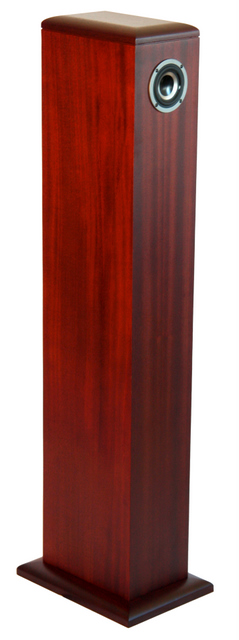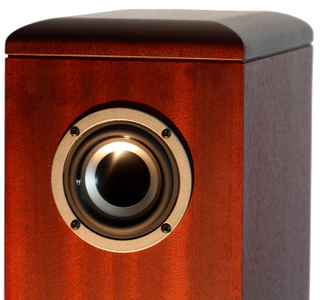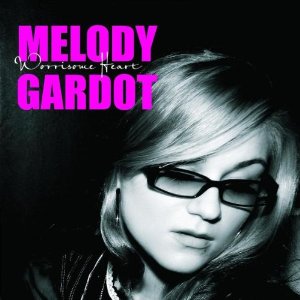Acoustic Technologies Classic Series Loudspeakers
| Little Speaker—Big Sound |
|
|
|
February 2011 |

After too many years at CES and T.H.E. Show I had grown weary of expensive boxes and worse yet, monoliths that loomed over me as cost-no-object tributes to their designer’s ego. I must not forget to mention my personal favorite, loudspeakers that required a quarter of an acre in floor space for amplification. Every home should have a system like that. Perhaps I should not be too critical because the envelope-pushers and risk-takers show us what is possible. The problem was that frequently the results did not justify the means. The rooms all sounded pretty much “me-too” and were less than engaging. Some of the most venerated loudspeakers sounded the worst because I could not get anywhere near the sweet spot due to all the attention they attracted.
Imagine my surprise when, two steps into a suite at the Venetian, I was captivated by what I heard. Then I saw the modest offering, Acoustic Technologies Classic Series Loudspeakers, and knew it was not possible. Duh, check it out dude. Half of the suite is empty and the other half only has one pair of skinny speakers and a small equipment rack. This does not compute. It’s a trick I thought–look for mirrors, look for mirrors! Both in performance and Spartan appearance, this room was the antithesis of many of the rooms I had just visited.
David Maeshiba, the speaker’s designer, sensed my consternation and proceeded to demonstrate the speaker’s abilities. He invited me to walk around the lower half of the suite—the empty half. Then, with a sly grin, he invited me to stand with my nose in the corner like an errant schoolboy. I never lost touch with the music. It followed me everywhere. This was quite a contrast to the more anal-retentive rooms where the listener was forced to sit strapped to a backboard in a narrow sweet spot while the focus on absolute fidelity and pinpoint imaging stripped the music of any life or spontaneity. How many ways can I say boring?
OK, this for sure was David (Maeshiba) going up against the industry Goliaths and scoring serious body blows. Music from the Classic speakers was full-bodied and holographic. It filled both halves of the hotel suite and surrounded the listener yet there was still a well defined soundstage and focal point. The listener did not have to fixate on the spot between the speakers and feel excluded if they let their bodies wander. It was like changing seats in a well-designed concert hall except that this was just another suite in the Venetian Hotel towers.
Off-axis listening was some of the best I have heard. During part of my audition one speaker was turned 90 degrees to the outside. Some focus was lost but the soundstage did not collapse and music was still very enjoyable. Maeshiba cheerfully described how one listener was offended by a slightly askew speaker and demanded it be straightened. He then pronounced it “much better”. Perhaps his last name was Monk. I relate this anecdote because it plays a role in speaker placement. As I will explain later, symmetry is neither mandatory nor necessarily desirable with the Classics.
I paid the Acoustic Technologies room a second visit in 2009 and two additional visits at CES 2010. Each time I came away with the same admiration and sense of reprieve from the more exotic and pretentious rooms. Here was an affordable speaker with a small footprint that should work very well in a real-life setting—namely the average listening room that was designed for anything but music. However, I should caution here that each of us has different values when it comes to music reproduction. Maeshiba candidly shared with me that while many listeners compliment him and spend extra time in the room to enjoy their music, some “don’t get it”. They give a polite thank you and quietly exit. I have done the same graceful exit from many rooms with well-reviewed and respected equipment. That does not make anybody right or wrong. It is just a reminder that regardless of my honest efforts here, your experience may vary.
Design:
 The elegance of their simple exterior hides a modified back-loaded horn design using a single 3” full-range driver with titanium cone with no crossover or filter. The speaker cabinet is designed to function as an amplifier and resonator. The internal wiring is high-purity (99.99%) solid silver. The Cardas gold-plated copper binding posts are located in the 4 ¾” by 7 3/8” horn opening at the bottom rear of the speaker.
The elegance of their simple exterior hides a modified back-loaded horn design using a single 3” full-range driver with titanium cone with no crossover or filter. The speaker cabinet is designed to function as an amplifier and resonator. The internal wiring is high-purity (99.99%) solid silver. The Cardas gold-plated copper binding posts are located in the 4 ¾” by 7 3/8” horn opening at the bottom rear of the speaker.
Speaker Placement:
David Maeshiba’s seemingly cavalier attitude toward speaker positioning was deceiving as I soon learned when I finally had the speakers in my listening room. There was some method to his madness. I discovered that too far from the rear wall the speakers lost focus and weight. But too close to the rear wall the sound became two-dimensional and lost soundstage depth. Distance to the wall behind the speakers is also a critical factor in achieving a balance between bass and the higher frequencies. I also discovered that if the speakers were too far apart focus and weight were lost.
Maeshiba recommended moving the speakers closer together and toeing them out or using an asymmetrical toe. Toe out! He assured me he was serious. Well serious is as serious does. Toe out and asymmetrical both worked well but to my ears symmetrical toe in worked a little better in my rectangular room. Admittedly, I am overly fond of symmetry. Perhaps Mr. Monk is a distant cousin. The point here being that asymmetrical toe in/out can be used to accommodate listening room dimensions and furniture placement. As the drivers are toed out, the horn opening is toed in. An asymmetrical position reduces bass boom by creating a slightly different room mode for each speaker.
Maeshiba kindly stopped by my home after the California Audio Show in Oakland, CA. He tweaked the speaker positions very slightly from what I was using. The final speaker position ended up being 29.5” from the front wall to the speaker face, 60” between inside edges and 0.5” of toe in. This left the speakers just over 3’ from the side walls and avoided serious corner loading. This placement was very room-friendly and the speakers were not intrusive.
Amplification Requirements:
Assuming a 3” driver should be easy to drive was a mistake I made. Through experimentation and later, through confirmation with Maeshiba, I found out the speakers needed an amplifier and/or preamplifier with a lot of gain to maximize the dynamic response and create the holographic presentation.
I wanted to try the Classics with both tube and solid state amplification. I opted for something that a budget-conscious user might choose. To that end I tried both a Denon AVR 3803 home theater receiver and an Acurus A200 amplifier. The results were a disaster. With both amplifiers the sound was two-dimensional and abrasive. I was horrified by how much noise I was hearing. It was too painful to continue.
That was in sharp contrast to the two tube amplifiers I used. Both were very musical and invited extended listening sessions. Maeshiba informed me that he places a follow up telephone call to all of his customers to ensure their satisfaction and has found that most of them use tube amplifiers with the Classics.
The first tube amplifier I tried was an Ayon Orion integrated amplifier which I used in the 40W-triode mode connected to the solid-state DAC in my Nova Physics Memory Player. I thoroughly enjoyed this combination.
The second tube amplifier I used was an Audio Note Kit 1 (8Wpc, 300B stereo single-ended triode). While this amplifier has a gain control knob it is really only an attenuator. The Audio Note provided much better results when used with an Ayon CD-5 (combination transport/DAC/preamplifier) preceding it to provide additional gain. To avoid the ADC conversion of the analog inputs in the CD-5, I primarily used my Memory Player as the digital source and used the CD-5 for DAC and preamplifier functions. I did briefly use the CD-5 as a source for comparison purposes. I was not able to keep the Orion long enough to do a thorough A/B comparison of the two amplifiers but I can say the two amplifiers were very similar in character on the Classics and both were very enjoyable.
Still, these two fine tube amplifiers lacked some of the punch and excitement I had heard at CES. Pairing the Classics with a Pass Labs X1 preamplifier and First Watt F3 solid-state amplifier added that extra bit of punch while maintaining a surprising tube-like character.
Obviously any speaker review cannot (and should not) be completely without regard to its ancillary electronics and cables. The best a reviewer can hope to do is accurately portray the basic character, strengths, and limitations of a speaker and give some guidance on what works or does not work in the supporting cast. To that extent my observations below are remarkably the same concerning the tube equipment and the Pass/First Watt pairing with the Pass/First Watt winning my preference for extra dynamics while maintaining a warm and full-bodied presentation.
That is not to imply the Classics did not reveal subtle differences because they did. For example, inner detail from the Classics was very good but there was more detail using the Memory Player as the source than with the Ayon CD-5. Also the CD-5 as a source gave a warmer and slightly lusher presentation than the Memory Player which tended to be drier and more neutral.
Listening Impressions:
Readers should be aware of the intrinsic limitations of a single-driver design. Superb cohesion is the prize but the sacrifices are less extension at the extremes. I won’t try to convince you that the Classics plumb the depths on bass or capture the full magic of violins. The vast majority of speakers cannot lay those claims (legitimately). And some that do only end up being painful to listen to with room thudding bass or piercing highs and that being at multiples of the price of the Classics. What I was listening for with the Classics was a speaker that could reproduce the essence of the music and move hearts and feet. The Classics easily delivered on that promise.
 The a cappella choir,Ladysmith Black Mambazo ebbs and soars on the tracks “Diamonds on the Soles of Her Shoes” and “Homeless” on the remastered release (2004) of Paul Simon’s CD Graceland[Warner Bros. R2 78904]. With the Classics, their well-practiced harmonies have visceral impact and maintain both differentiation and blending. It is obvious there are multiple voices carefully tuned to each other while at the same time there is no smearing or muddiness.
The a cappella choir,Ladysmith Black Mambazo ebbs and soars on the tracks “Diamonds on the Soles of Her Shoes” and “Homeless” on the remastered release (2004) of Paul Simon’s CD Graceland[Warner Bros. R2 78904]. With the Classics, their well-practiced harmonies have visceral impact and maintain both differentiation and blending. It is obvious there are multiple voices carefully tuned to each other while at the same time there is no smearing or muddiness.  On the track “Worrisome Heart” from Melody Gardot’s CDWorrisome Heart [Verve B0010468-02] I would have liked a little more extension and sparkle on the piano. Otherwise the vocals, piano, and brass all clearly benefited from the single-driver, no crossover design. The presentation was seamless and deliciously smooth.
On the track “Worrisome Heart” from Melody Gardot’s CDWorrisome Heart [Verve B0010468-02] I would have liked a little more extension and sparkle on the piano. Otherwise the vocals, piano, and brass all clearly benefited from the single-driver, no crossover design. The presentation was seamless and deliciously smooth.
The track “You Don’t Know Me” from Emmylou Harris Cowgirl’s Prayer [Asylum 61541-2] seems to have been written especially for the Classics with both Emmy Lou’s voice and the pedal steel guitar breaking my heart. Almost crying, the holographic guitar presentation envelops the listener instead of launching at them. This is one of the demo tracks I use at CES and other shows. I have heard it on over hundred systems and I cannot remember ever hearing it done better than the Classics performed in my home.
Reviewer in the Other Room:
I am restless by nature so sitting quietly facing two speakers is frequently too much like a desk job. Even more so if the music encourages audience participation or my stomach encourages me to be in the kitchen. I have chores to do and appreciate it when speakers like the Classics can provide me with a realistic presentation far off axis. They are among the best I have ever heard in that respect. One of their strong points is they anchor the sound stage but allow the listener to continue to enjoy an excellent experience of the music far off axis much the way a well designed concert hall would do.
Conclusion:
One attribute I prize highly, perhaps beyond all others, is coherency. Single-driver speakers are the reigning champions for coherency. Sure there are concessions at the top and bottom frequencies but many multiple-driver speakers make the same concessions without offering coherency as the consolation prize. Frequently multiple driver speakers “over achieve” with too much bass or a harsh top end or their cohesion fails at frequency or volume extremes.
For most music, bass from the Classics was satisfying both in quantity and quality. Most important, it was balanced, surprisingly solid, and appropriate. Many speakers, in an attempt to increase bass, throw it out of balance with the rest of the music. This was not the case with the Classics. However, I would not have objected to more bass in some instances provided the quality could be maintained. My main system has paired subwoofers and I don’t have to worry about offending neighbors so I am used to more bottom end.
While the upper frequencies were not as extended as with multiple-driver speakers, they were not truncated and had a natural decay. My only criticism of the Classics is I would have preferred more top end extension on pianos, guitars, and (especially) violins.
Can I say there is no box coloration with the Classics? I expected some due to the design but as I changed components I realized what I was hearing was merely reflective of the ancillary equipment. I could definitely make the Classics go lean and mean or fat and warm depending upon the associated electronics. If I did hear any coloration it was slight and not objectionable. In fact it provided a pleasant warmth and body.
All speakers make compromises and certainly the Classics were no exception. But I did not find them objectionable. I was too busy thoroughly enjoying the music. Many speakers can capture the basic core of music. But the Classics did not capture it; they set it free. Music had life and a presence that made me feel like I was there. Unlike many more costly speakers, the Classics get out of the way of the music. In another sense, they get out of the way period since they are so room-friendly and beg to be listened to off-axis. Although they perform very well in a small listening room, they also thrive in modern, open-architecture living areas. In short, these speakers are for real-world listening conditions.
![]()
Specifications:
Driver Type: Three inch full-range titanium cone
Crossover/Filter: None
Nominal Impedance: 8 Ohms
Rated Power Input: 15 Watts
Maximum Power Input: 30 Watts
Dimensions: 43 1/4H x 6 1/4W x 9 ¾D
Net Weight/Speaker: 35 lbs.
Price: $2650 MSRP
Address:
One North Wacker Drive
Suite 4130
Chicago, Illinois 60606
Telephone:
630-285-1005 Sales/Distribution
312-948-4400 Corporate
Fax: 312-984-0146
Email: Info@singledriver.net
Websites: http://www.acoustictechnologiesllc.com
http://www.singledriver.net
![]()
Don’t forget to bookmark us! (CTRL-SHFT-D)
Stereo Times Masthead
Publisher/Founder
Clement Perry
Editor
Dave Thomas
Senior Editors
Frank Alles, Mike Girardi, Key Kim, Russell Lichter, Terry London, Moreno Mitchell, Paul Szabady, Bill Wells, Mike Wright, Stephen Yan, and Rob Dockery
Current Contributors
David Abramson, Tim Barrall, Dave Allison, Ron Cook, Lewis Dardick, Dan Secula, Don Shaulis, Greg Simmons, Eric Teh, Greg Voth, Richard Willie, Ed Van Winkle, and Rob Dockery
Music Reviewers:
Carlos Sanchez, John Jonczyk, John Sprung and Russell Lichter
Site Management Clement Perry
Ad Designer: Martin Perry





Be the first to comment on: Acoustic Technologies Classic Series Loudspeakers